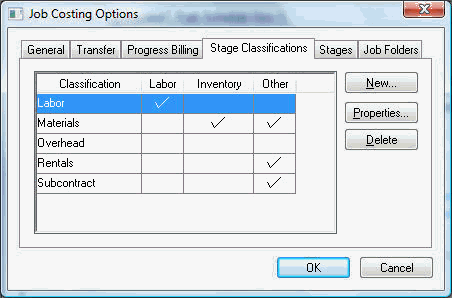Job Stage Classifications
The Stage Classification settings are used to classify different groups of expenses and to determine the source of these expenses. The most common classifications include labor, materials, rentals, and subcontractors. The source of the expenses (payroll, expense invoice, or inventory) for each stage is restricted by the stage classification. A few different classifications are sufficient for most companies. It is important to create the most common classifications before stages are created and to properly design the classes, since classifications cannot be deleted if a stage is using the unwanted class.
-
To add or edit stage classifications, go to Job Costing > Options > Stage Classifications tab:

-
Click the New button to add additional classifications and the following dialog will appear:

-
Enter the Classification description.
-
Enter the classification Source. The classification Source determines which source documents will contribute to the actual cost of the job stage.
-
-
A classification with no source settings is considered an overhead classification. Review The Overhead Stage section for more details about the overhead stage.
-
Switch the Source option Labor ON if any stage within this classification contains payroll costs. All stages classified with a classification that has this option OFF cannot be used within an employee's timecard. Additional hour totals show on the Totals tab of the stage window if the stage is classified with a Labor source.
-
The Inventory switch should be turned ON for stages that contain inventory item costs. This switch must be turned ON to allow perpetual inventory items (Track Count Items) within a stage. This applies to Track Count inventory items in both the expense invoice and the inventory transfer.
-
Turn the Source option Other ON if the stage with this classification may be used within an Expense Invoice.
-
-
-
Turn all Source options ON (Labor, Inventory, Other) to allow the stage to be used within any entry window.
-
The Add Overhead To Budget option should be OFF unless you wish to apply the overhead percentages to the budget amounts and the actual costs. This switch is normally turned OFF since the overhead costs is normally included with the budget amount entered by the user. Review Adding Overhead to the Budget Total for more details on this option.
-
Click the OK button to finish creating the classification.
In the Stage Classifications tab, click on the Properties button to change the classification name or source settings. The classification can be renamed at any time and all classification labels within a job stage will be changed immediately.
Click the Delete button to remove a classification. A classification cannot be deleted if any one stage exists that is classified with the highlighted entry.
Click OK to save the list of classifications.